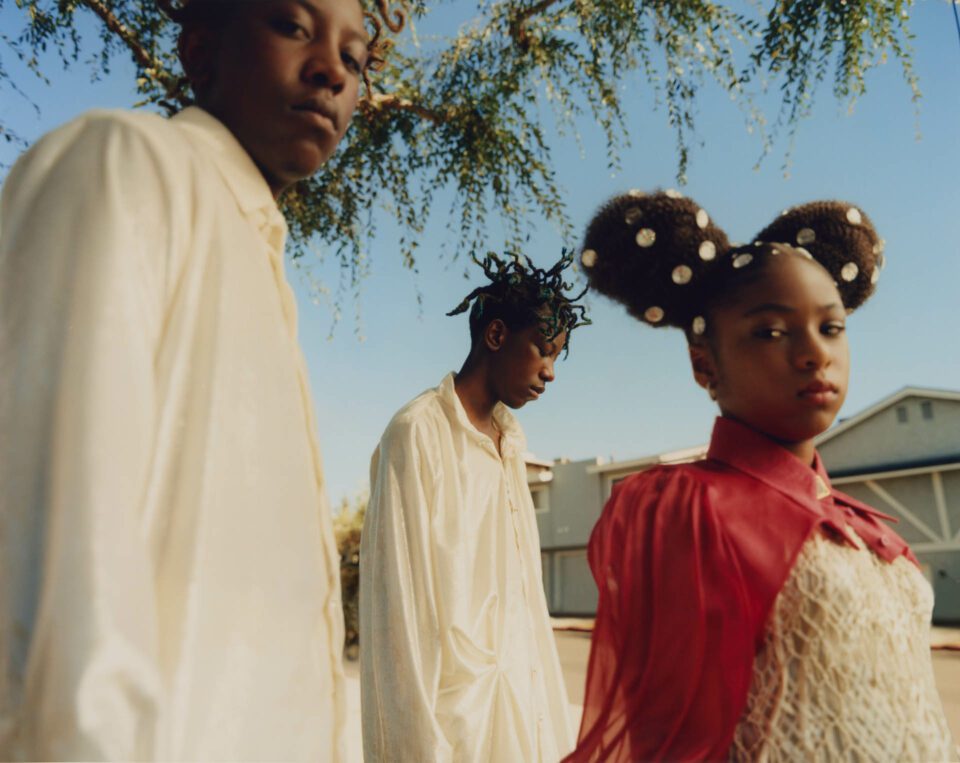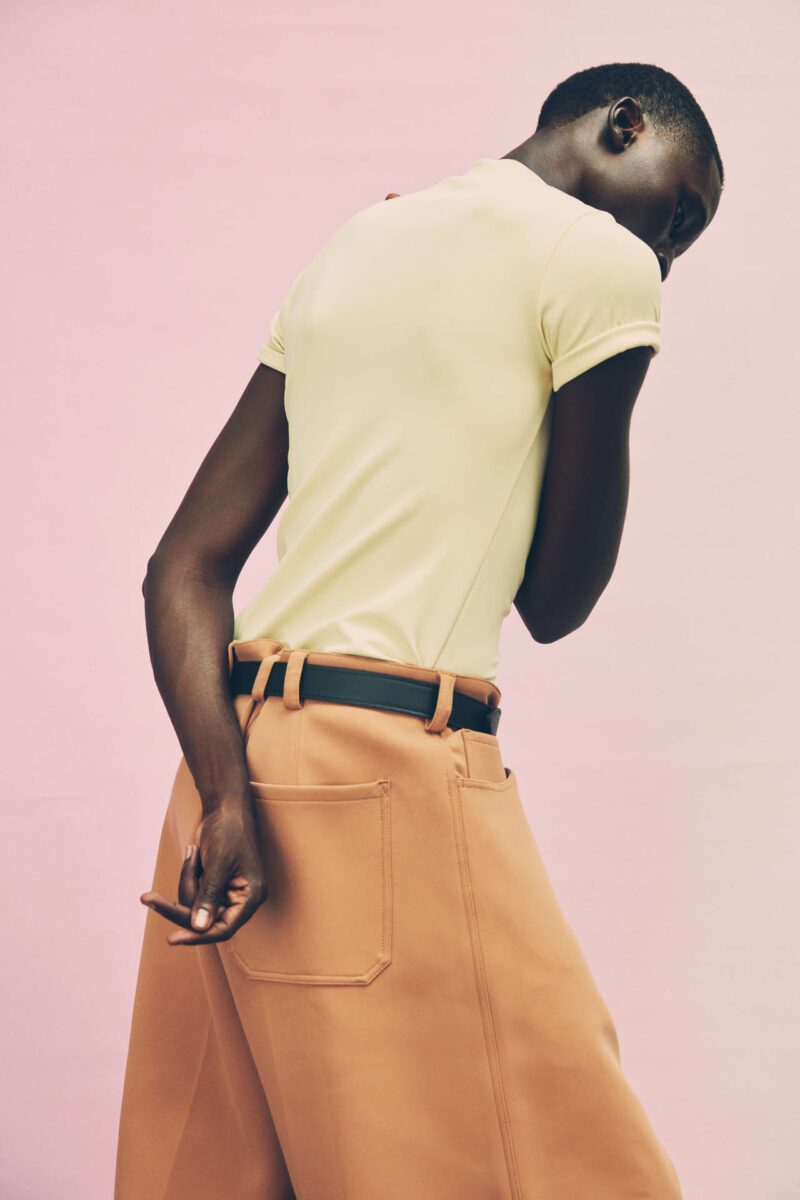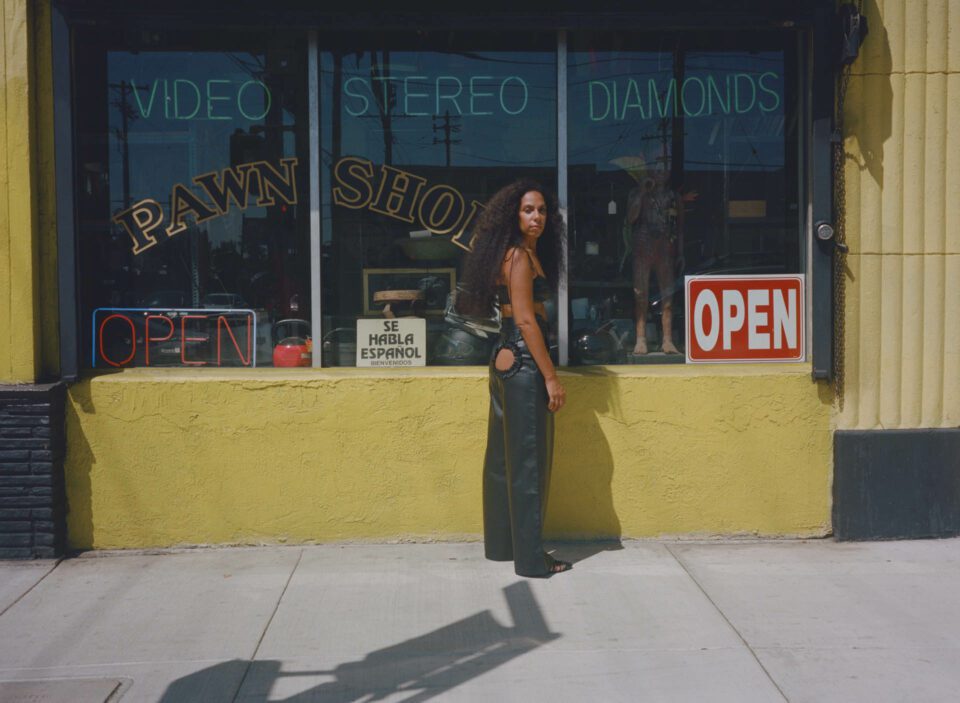In Fulton Street, a photograph taken by Micaiah Carter (b. 1996) for Document Journal in 2018, a girl sits on an orange seat in the subway in New York City, attired in an oversized sweater as tight curls spill over her shoulders. Holding the pole for balance, she peers into the lens with a vulnerable gaze. A warm light bathes the entire picture, softly radiating from the window of the train, and haloing her in a fiery glow. The picture has the resonance and spontaneity of a street shot, as if Carter snapped a perfect candid moment before the train stopped at Fulton Street station in Manhattan, the letters flashing up on the digital passenger display. And yet, the subject in the photograph is professional model Alexis Morgan, styled and staged in the most effortless way, and Carter is shooting on behalf of a major fashion magazine for a feature on resort style as worn by youth across the Atlantic.
The humanism of documentary portraiture converges with the bold glamour of fashion photography in Carter’s gorgeous images, collected for the very first time in Micaiah Carter: What’s My Name, a highly-anticipated release from Prestel. It includes pictures captured over the past decade for upscale clients and publications like Elle, GQ, The Fader, Cultured Magazine, Clinique, Pattern Beauty, Burberry and more. The book comes at a time when young Black image-makers are making serious waves in the art world, with seminal exhibitions like Antwaun Sargent’s The New Black Vanguard (2019), which features Carter, bringing the likes of Campbell Addy, Nadine Ijewere and Tyler Mitchell to global audiences. Destinations for the touring show are numerous, including London’s Saatchi Gallery, Fotografiska Stockholm and Cleveland Museum of Art. The result is a transformation in culture and media representation in the USA and beyond.

Despite the global reach of his work, and his impressive list of clients, Carter’s book is also about the aesthetic and conceptual roots that ground his practice. The photographer’s stunning high-end shots are interspersed with Polaroids from the 1970s and 1980s, depicting his own family in the southern United States and California. Carter grew up in Victorville, a small town on the western edge of the spacious Mojave Desert, one hour and forty-five minutes outside of Los Angeles. At the time, the sparsely-populated city had a single shopping mall, a movie theatre and a museum chronicling the famed American highway Route 66. Here he attended a prep school, where he was one of a very few Black students.
During this time period, family photo albums provided a notion of belonging, tethering him to a tangible sense of history. “It just gave me confidence. Seeing the feeling of pride, identity and individuality throughout all the photos really inspired me to be myself, and to know there’s no limit, stereotype or box I need to be put in to be accepted or to be Black.” It’s this feeling – of self-acceptance – that would later influence his own visual practice when he moved to New York at the age of 18, after winning a scholarship to study photography at Parsons. Moreover, the solitude of life in a desert town enabled Carter to discern the beauty in everyday objects at an early age, and develop a keen eye for the interplay of light, subject and environment. “Growing up in the mundane inspired me a lot. Being in the desert alone, the light out here is really amazing; it affected my photography down the road.”
Indeed, light illuminates the natural beauty of Carter’s subjects, allowing them to tentatively reveal themselves rather than having an external viewpoint imposed upon them. Whether confronting the camera with their gaze, staring outside the frame, or softly closing their eyes, they invite viewers to a secret, almost magical world, bound together by the relationships Black people hold with each other, especially in the realm of friendship and family. This is especially evident in Carter’s portraits of children and youth. “My father passed about three years ago [from cancer], and during that time I got to look back at a lot of old videos he’d taken of me and the family in the 1990s and early 2000s. His ability to be grounded was a big inspiration for me. To see the beauty in everyone, to not judge so quickly, but to use your discernment. Soul is a big thing that my father taught me: having soul and a connection to your spirit.” As such, empathy and love pervade many of the compositions shown in this book.

Carter has also found inspiration in the confidence and aesthetics of the Black Power movement of the 1960s and 1970s, when organisations like the Black Panther Party redefined Blackness not only through politics and protest, but through style. They reclaimed Afros, wore leather jackets and flares, and followed in the footsteps of the 1960s Black is Beautiful movement, when photographer Kwame Brathwaite and the African Jazz-Art Society & Studios launched fashion show Naturally ’62, featuring Black models who rejected western beauty standards. This period remains a wellspring of inspiration for Carter, not least because his father, a soldier on the frontlines of the Vietnam War, also embodied the tumultuous politics of the era. “A lot of the photographs of my dad simply inspired me because of the Afros and Black pride. The swagger of it, honestly, it’s so cool. These things really came together to give me a sense of my own identity.”
In Alton in Brooklyn (2016), a slim young man holds an Afro pick over his hair, sun dappling his skin, eyes downcast as he engages in the ritual of self-care. Alton Mason, who became the first Black male model to walk for Chanel in December 2018, is the star of this shot. The outdoor lighting, industrial background of a closed steel door, and open posture suggest he could be anyone: a friend, a neighbour, a random person encountered on the street, or even a member of Carter’s own family. That’s precisely the point Carter wishes to make, seeing his work as an extended family album.
There is a specific feeling Carter gets when he sees people who inspire him: one of nostalgia, the tingling warmth of childhood, and of being immersed in the golden hue of innocence and the buoyant faith of being cared for by loved ones. It’s a recurring theme in his work, and an environment he’s deliberately trying to convey. “That’s an atmosphere I really love, something that makes you feel warm, like you’re in a blanket and you’re relaxing, cosy, sitting next to a fire with loved ones. I try to give the same quality to the people who inspire me, as I do to my family when I’m taking photos of them. So, in a way, they feel like they’re part of the family.”
Celebrities and beloved artists who appear in What’s My Name range from Get Out star Daniel Kaluuya and iconic rapper Megan Thee Stallion to pop singers Playboi Carti, Solange Knowles, The Weeknd and more. As the reader turns the pages, celebrities pop up with the same unassuming posture and quiet vulnerability as the rest of Carter’s subjects, illustrating their humanity. “Having an approach that’s downto- earth, but also super creative, can create something really special because it’s not forced. I never want my photos to feel like something was forced on somebody. It’s big on collaboration and trust. If you have that, then your subject is going to be really relaxed to create something new and different.”

Carter grew up in the 1990s and early 2000s, and this period of pop culture continues to inflect the tone and feel of his portraits today. He cites Beyoncé, Britney Spears, Erykah Badu, Lady Gaga, Missy Elliott and Outkast amongst his major inspirations. More visual influences include Marvin Gaye’s painted album cover of Sugar Shack by trailblazing Black American artist Ernie Barnes; the visually arresting cinematography of Blaxploitation filmmaker Spike Lee; John Singleton, who directed the 1991 coming-of-age crime drama Boyz n the Hood starring Ice Cube, Nia Long, Cuba Gooding Jr, Angela Bassett and more; and the groundbreaking portraits of Carrie Mae Weems. Fashion and visual culture of the 1990s, particularly in the context of Black life as portrayed on-screen, materialises in Melina Matsoukas (2020). The acclaimed film and video director, attired in leather with spaghetti straps, stands in front of a pawn shop. “Video”, “Stereo” and “Diamonds” blaze in glowing green letters above the neon open sign. The shot has a gritty, wistful feel.
Carter’s core values of self-acceptance, paired with this early-noughties visual style, mean it’s no coincidence that a significant portion of his commercial portfolio is situated in the beauty world. Collaborators include Pattern, Tracee Ellis Ross’ company catering to people with kinky and curly hair, and make-up giant Clinique, for which Carter depicts three women wearing hijabs in luminescent, matte-coloured eyeshadow, as they regard the camera with a regal gaze. A similar approach appears in his fashion campaigns. Optimism, a project with WeTransfer / WePresent, stemmed from the fashion of Black church-goers, dressing in their finest clothes on Sundays. In Untitled (2022), Londyn wears an elegant white dress with a lightweight scarlet shrug, her hair styled in dramatic Afro puffs embellished with white buttons. She casually looks towards, and beyond, the lens. Likewise, in a shot for Elle USA, model Baba Diop leans away from the camera, his rich dark skin softly contrasting with a baby pink background, clad in pastel yellow shirt and bold orange trousers.

Colour and light play vital roles in Carter’s work. This is perhaps best captured on the book’s front cover, where numerous droplets of light partially illuminate Alton Mason’s face, as he bounces a basketball in his hands, wearing a gold sequined tank top. The effect of shining light on different skin tones results in contrast, illumination, silhouetting and, sometimes, even occlusion – partial or whole – depending on a subject’s position and the manipulation of natural or artificial light. It’s a technique that Carter successfully hones.
The dance of shadows and hues characterises Carter’s style of shooting, showing his subjects in a naturalistic way and allowing Blackness to be visible rather than hidden or suppressed. More than anything else, these incandescent gold tones set the warm, glowing atmosphere of his pictures, which is the hallmark of his singular creative vision. “It builds fantasy, a world that’s unseen. I’m trying to give a feeling, and I’m trying to get a sense of nostalgia. I’m trying to tell a story in which you don’t even notice the camera is there. This is a candid moment. And I love photography that isn’t too posed. There’s something special that comes from those unexpected moments, from thinking outside the box and creating [a picture] for a viewer that they can feel they’re a part of.”
Micaiah Carter: What’s My Name | Prestel Publishing
Words: Iman Sultan
Image credits:
1.Untitled, (2017) . © Micaiah Carter, (2023). Talent: Kendall Harrison.
2. Alton in Brooklyn, (2016). © Micaiah Carter, (2023). Talent: Alton Mason.
3. Untitled, (2022). © Micaiah Carter, (2023). Publication: WePresent. Talent: Londyn, John Arthurs, Nathan Arthurs.
4. Untitled, (2022). © Micaiah Carter, (2023). Publication: Elle USA. Talent: Baba Diop
5. Untitled, (2017) . © Micaiah Carter, (2023). Talent: Kendall Harrison.





